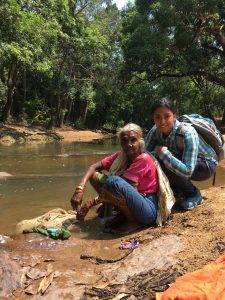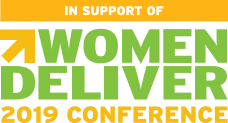 Helina is a National Geographic Explorer and PhD candidate at the Institute for Resources, Environment and Sustainability (IRES). Broadly, her research interests are ecosystem services, Indigenous rights, gender studies, biodiversity conservation and environmental policies. Her doctoral research will examine how the relationship between Adivasi communities and forest ecosystems changed as a function of post-independence forest policies of India. She is the founder of the project ‘The Everyday Nature,’ an international project that aims to document the perceptions of people towards nature. Before joining IRES, Helina worked in India for nearly six years on various environment and development sector projects in association with Ministry of Environment Forest and Climate Change, Government of India, Deutsche Gesellschaft für Internationale Zusammenarbeit GmbH (GIZ), Centre for Science and Environment and Clinton Climate Initiative.
Helina is a National Geographic Explorer and PhD candidate at the Institute for Resources, Environment and Sustainability (IRES). Broadly, her research interests are ecosystem services, Indigenous rights, gender studies, biodiversity conservation and environmental policies. Her doctoral research will examine how the relationship between Adivasi communities and forest ecosystems changed as a function of post-independence forest policies of India. She is the founder of the project ‘The Everyday Nature,’ an international project that aims to document the perceptions of people towards nature. Before joining IRES, Helina worked in India for nearly six years on various environment and development sector projects in association with Ministry of Environment Forest and Climate Change, Government of India, Deutsche Gesellschaft für Internationale Zusammenarbeit GmbH (GIZ), Centre for Science and Environment and Clinton Climate Initiative.
Helina is a Commonwealth Scholar and a graduate from the London School of Economics and Political Science. She is a mother to an incredibly naughty boy, staunch advocate of women empowerment, huge foodie and loves to paint in her spare time. Contact: helinajolly@alumni.ubc.ca /helinajolly@gmail.com
Gendered human-nature relations
Through my PhD research, I aim to understand human-nature interactions among the Indigenous communities of the Western Ghats in India. For my study, I work closely with forest-dwelling Kattunayakar Adivasi communities of Wayanad (Kerala, India). They are foraging societies that live within forests or fringe forest areas and are primarily dependent on forest services for their livelihoods.
While India is a Hindu majority country that delineates societal dynamics through principles of patriarchy, Adivasis are animistic, and matriarchal codes primarily drive several of them. Every time I mention Adivasi communities, please bear in mind there are more than 400 culturally, socially and traditionally diverse and distinct societies who can speak for themselves. In my work, I represent the philosophies and ethics of only one among them.
Although, gender dynamics within some Adivasi communities are studied, not many investigations have explored this aspect among forest-foraging societies such as Kattunayakars. The current literature tends focus on dynamics of natural resource use and access among the men and women associations of rural Adivasi peoples. However, fewer works describe how these gender dynamics set the tone that guides their perceptions towards forest services and resources, how government and social policies differentiate women and men, and how those have disparate impacts across gender.
What I have observed from work and experience of interacting with communities is that gender is a component that necessarily influences communities’ security, livelihood and rights. Identifying the undercurrents of gender is not an easy task, especially if you are trying to study with traditional rural communities such as Kattunayakars. Gender is an inconspicuous entity that you will not find if you simply walk into the community. Hence, learning about gender requires specific training and skill sets even for experienced researchers.
Unfortunately, mainstream gender dynamics hold such strong and prevalent historical-cultural associations that new laws and regulations automatically or organically absorb them. For instance, the majority of regulatory norms treat men as heads of their families conferring them with the exclusive right to land or access to forests. These norms are evident during the discussions of conservation-driven displacement of Adivasi communities. When the government provides land to communities displaced from forest lands, newly allocated rights to property are often given to the men in the family. “Rights to land” will also mean that men in the family get to decide what crop to grow, when to grow and if they want to sell the land. Men get to make the decisions because women are not entitled to land after these displacements.
While women’s role is traditionally to collect the fuelwood, get water for their families or access food sources from the forest, after displacement from forests, women still have to go back to the forest, walk that extra distance to ensure that the family gets the necessary basic subsistence materials. The impact of resettlement disproportionately affect women as well. The challenge is that, inherently, women think that’s their role. Therefore, they will continue to do that, no matter what further hardships they come across.
Despite these gendered differences, both Adivasi women and men are adamant about their need to access forests for their daily life systems. In their forested territory, both men and women are equally dependent on the forest; they seem to have more equality in their dynamics, men and women. For instance, when women go into the forest and men would cook food and take care of their children and vice versa. But, as the Adivasi communities are relocated and become more settled (or increasingly agricultural-based) Adivasi communities, gendered hierarchies and imbalances increase. They mimic mainstream society. Gender dynamics change according to the Adivasi community I am interacting with; if they are entirely forest-dependent, I sometimes see them playing a more egalitarian role in their social structures.
Gender dynamics can be in terms of simple things like how men and women see human-animal conflicts differently. Gender also affects things as complex as emotions and spiritual relations. In terms of relationship with nature, I view relationship in terms of material dependence and non-material dependence of the community. I want to try and see how men and women answer those questions differently.
 Feedback and the local-global research cycle
Feedback and the local-global research cycle
Whether it is feminist political ecology, ecofeminism, or women and development, these schools of gender critique originated in combination with natural resource management studies. These studies call for a need to make a conscious effort towards integrating more gender-specific approaches in analyzing everyday human activities, especially in traditional rural societies. While my research work may be providing evidence of gender dynamics at a local level, it may be contributing lessons to global research cycles. These local lessons and feedback may appear as small, yet they can add momentum to the worldwide pursuit of ensuring gender equity and equality. At this moment, my work may seem just like a drop of water, but lest we forget that such drops someday make rivers and oceans.
The personal trajectory towards gender work
My interest in gender issues started way before I joined UBC. For the last six years, I’ve been working with several rural communities in India on various developmental challenges. Agreeing with the global dialogues and discussions on gender, addressing gender component of projects has become mandatory for international development programs and projects. While the majority of the agencies treat ‘gender’ as a checklist, it is often implemented in the limited or inappropriate ways. The possible reasons for such erroneous approaches to gender are that few people acknowledged gender issues as real; others are unaware of what methodology is to be used. Through my work, I plan to bring my experiences and learnings to learn how we can improve the way gender is studied and addressed in research. It is going to be a long project!
Growing up in rural India, gender-based discriminations were blatantly visible in everyday life. Sometimes I witnessed it in the form of female infanticide, or practices such as dowry (money and expensive materials given to the groom by the bride’s family) and sometimes in simple discourses such as “What use it is to educate a daughter?” I felt that at some point actions needed to be taken. As a woman, I believe it is my personal goal and responsibility to bring some component of the ‘gender conversation,’ associated struggles, and criticisms, into my work.
Canada and Canadian educational institutions are marching forward with their progressive agendas to make spaces gender-equal. In this discussion, the University of British Columbia is not far behind. More specifically I can speak for my institution IRES, where we have (almost) equal proportion of men and women professionals. There is a real danger when emerging researchers and academics do not see people like them represented. As a young female student of colour and mother, it makes a huge difference when I see people I relate to in academic positions.
Every time I see (especially women) professors with a kid that makes me feel more empowered about my personal choices and struggles. It makes my aspirations real and achievable–that belief is strong and contagious.
In order to make all of these changes to gender dynamics happen, what we need is more evidence, whether it is from a small community of Kattunayakars or at an organized institution such as UBC. Through my PhD work, I hope to gather more evidence in plural contexts for global communities to engage gender and strengthen the causes that support gender equality. It will bring them more people to work with, and more evidence is what is required to inform a movement reaching towards addressing gender equity issues.
Colonial legacies, caste patriarchy, and forest conservation
When the British and other colonialists came to India, they arrived with a resilient patriarchal legacy patriarchal approach to our Indian societies, which had multiple existing layers of hierarchy. They governed the states of India through these foreign principles and ideologies that perplexed the existing governing and social systems of India. True to its identity as a diverse country, India is a land of complex relations and dynamics –caste system, matrilineal societies, animistic beliefs, etc. The majority of Adivasi societies were traditionally egalitarian communities where women and men enjoyed equal status in relations. However, colonialists viewed India and people of India as one uniform whole, much as they mistook every other place they colonized. Because the British came with this narrow lens of seeing societies, they enforced policies that did not respect or even perceive that difference. When the colonizers would ‘grant’ land rights, these would be titled exclusively to male family members. That male-held documentation became the documentation for the Indian government after Independence. Colonial patriarchal interference continued without much understanding of Adivasi community structures and gender relations. One of the key colonial policies towards Adivasi communities is the ‘fortress approach’ to conservation, which fences in forests and keeps the Indigenous communities out, displacing them from their territories. This supposedly converts the forests into protected areas or reserve forest—the colonial the way of conservation. This continues to be the major strategy for Indian governments to conserve forests. Because I work with Adivasi communities as well as with the Forest Department, I’m most often working in these protected areas.
In parallel to this foreign form of patriarchy, there existed a more local Hindu caste system, an offshoot of the Brahmanical patriarchal philosophy. While the caste system is not officially accepted way of living in Independent India, it continues to dominate the existing governing and regulatory mechanisms. Adivasi communities were not traditionally part of the mainstream Hindu society. They were mostly animistic people, and they had their own Gods and Goddesses that guided their belief system. In the Indian community, they were placed in the lowest order partaking in tasks as bonded labourers and untouchables. While India has come a long way, Adivasis continue to remain far behind in development terms. Hindus writing government policy have considered Adivasi societies as similar to any other Hindu society where male member would be head of the communities.
Plural methodologies – from forest research to forest policy
With better expertise, skillsets and awareness, we need to start exploring policies and programs beyond the set colonial and caste ideologies. The word ‘gender’ is hardly addressed in Indian forest policies. Gender remains an alien term for the policies, and hence, it is a low priority for the government. Even though India is generating studies on gender equality and equity, but it’s not being converted into policy. It’s going to take time, and we need to bring forward more empirical evidence of gender difference, relevance and disparity. There is a need for deeper communication between academics’ and policymakers.
In my study, I work with both Adivasi communities and the Forest Department. I believe I would be doing an excellent job if I could bring both parties to a common understanding by translating the language of community to policymakers. It is supremely relevant to acknowledge the complexities of these dialogues and how context is driving discourse. For instance, use of word ‘gender’ is sometimes unappreciated among communities. My focus communities, Kattunayakars, have a practice of segregating menstruating women from home. They are not allowed to cook food or sleep inside the house. From an outsider perspective, it may look ‘primitive’ and oppressive toward women. However, during my visit, I observed that during this time of the month the men in the family took care of household work while women rested. Men actively performed tasks such as cleaning the house, collecting water, cooking food and taking care of kids. On being asked about gender equality, the women snap back “Our men know household work and help us in everything unlike your men.”
As researchers engage in discussions of gender, we need to be very careful about where and how we use methods and terminologies. In some communities, gender discussions can even lead to severe disruptions in their social and cultural fabric. Hence, what I try to do is make observations, and ask indirect questions to help me understand how gender works in the Adivasi context.
One important realization that I had from the field is that researchers may easily make unhealthy assumptions. As an outsider to a community, we need to understand that we are often not the right person to comment on their system. What I can do, in my capacity, is to make observations and translate them to a language understood by policymakers. In this way, I can bring change to the community, while hopefully not directly shaking their belief system or of their social fabric.
There are specific tactics that I employ to treat gender in my study.
In the initial round of my scoping study, I conduct interviews and observe whether men and women in the community share a different relationship with forests. It is noted that during these sessions, men and women mimic their answers so as to not contradict each other. Hence, it is essential to have interviews that are separate for men and women (after the scoping study).
Build a relationship with community members and take a strong stand either ‘for the community’ or ‘against the community’: don’t be a fence-sitter. Adivasi communities, like Indigenous Peoples across the world, are highly marginalized communities; they have always been disturbed by police and forest department. With a long history of atrocities and violence against these communities, they are conscientious about what they speak and to whom. Hence, it is essential for a researcher to make it clear for the community what you are attempting to study and where you position yourself.
There is work to be done identifying suitable methods in terms of research methods to address gender. As we are careful with ethics in research, researchers also need to get trained in identifying gender-conscious methods. If researchers were to have gender training, scholars would better determine if there is scope to include gender in their investigations. It’s essential to recognize that space, right? As an institution, I feel like UBC could curate a gender training platform for researchers.
Every study has the choice of addressing gender
Every study has a choice of addressing gender. Even if gender doesn’t individually add to your PhD, or your post-doc, bringing that dialogue up is essential for the movement towards for gender equity. If there is space to accommodate the gender aspect, it is vital to address that. I fear that sometimes’ gender’ as a term is treated frivolously without getting the attention it requires. While every study has space to accommodate gender, part of that is acknowledging that gender inequity needs our attention, as researchers.
On a day-to-day basis, I have to internalize and analyze gendered situations where I see equal or unequal numbers of men and women represented in academia. We need more dialogues so that even people who don’t make those internalized observations are made aware of those gender inequalities. It’s time that academia and scholarship take up gender in research earnestly and build tools, skills methods to address it appropriately.
 Faculty of Art
Faculty of Art